|
Handheld Nautiz X2
As competent and advanced as a modern smartphone, as functional as a dedicated mobile computer, and as tough as can be
(by Conrad H. Blickenstorfer; Photography by Carol Cotton)
Share on:




On July 12, 2016, the Handheld Group introduced the Nautiz X2, a new member of the company's Nautiz product line that includes both conventional rugged handhelds with keypads as well as toughened-up smartphones that can handle almost anything. The Nautiz X2 is one of the latter, a device that provides all the ease of use of a modern Android smartphone, but is also tough as nails. In this report we are analyzing the Nautiz X2 in detail and present our findings.
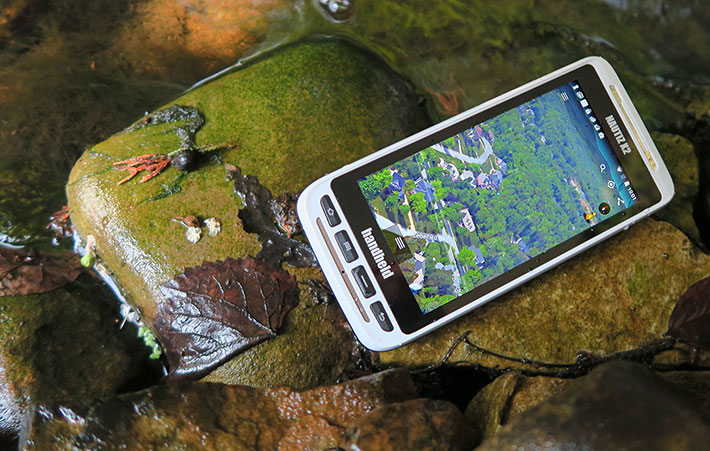
First a quick overview of what the Nautiz X2 is. That'd be an Android smartphone measuring 5.9 x 2.9 x 0.62 inches, weighing 8.1 ounces, and having a 4.7-inch capacitive multi-touch screen and an industrial-grade integrated barcode scanner.
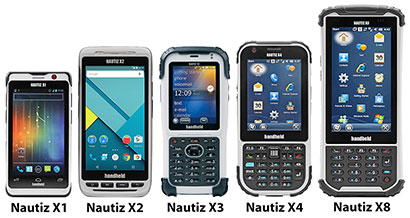 So the idea here was to create a device that's both a competent, modern smartphone as well as a workable data collection tool for the shop floor or the field. The image to the right shows how the new Nautiz X2 fits into the Handheld Group's current product line. So the idea here was to create a device that's both a competent, modern smartphone as well as a workable data collection tool for the shop floor or the field. The image to the right shows how the new Nautiz X2 fits into the Handheld Group's current product line.
Note that while the Nautiz X1 and Nautiz X2 are pure Android designs, the three keypad devices are primarily configured for Windows Embedded Handheld (though the X4 and X8 are also available with Android).
Also note the different emphasis in the two types of devices. Those that provide full modern smartphone functionality have large screens and contemporary consumer market designs, whereas the tool-for-the-job models have extra protection and physical keypads for rapid data entry.
How to design a tough Android smartphone for the field?
As of the second half of 2016, there are probably about two billion smartphones used around the world. The vast majority are consumer phones that either follow the latest fashion trends, or they are built as inexpensively as possible. If it's the former, they are likely fragile, glossy, very thin, and easily damaged. If it's the latter, they are cheaply made, and easily damaged. Neither is acceptable in business, and certainly not when the phone is used on and for the job.
Doesn't that present a great market opportunity for tougher phones that can handle getting dropped, rained on, or whatever else happens to small electronic devices during a typical day on the job? One would think so, but in reality it's amazingly difficult to succeed in that market. The lure of shiny, trendy stuff is very strong, and few want to pay extra for something that's tougher and won't break as easily.
Add to that the fact that ruggedized phones are tools for real jobs. That can mean industrial grade components that take extra space, larger batteries that can be replaced during a workday, special ports or controls, and perhaps extra hardware and software security provisions. All of that adds extra cost, size and weight.
So in order to have a chance at commercial success, the designers of a rugged handheld device must a) skillfully apply popular design concepts and features onto an underlying much more rugged platform, b) have a credible (if not incredible) spec sheet that gets the job done, and c) sell it at a price that convincingly confirms that its total cost of ownership is indeed lower than the consumer market if-it-breaks-just-get-another approach.
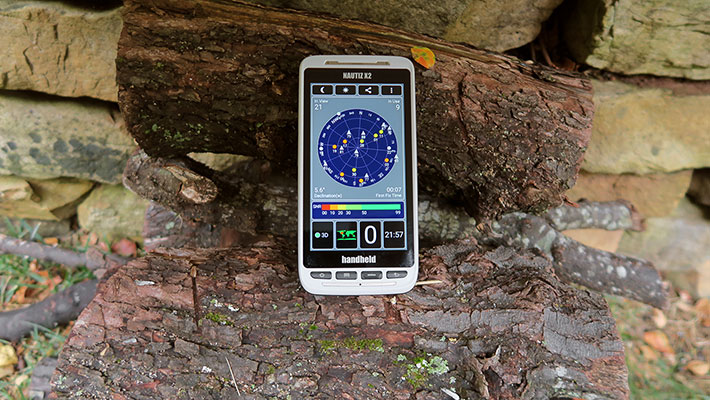
It also helps to have a track record of providing great products and excellent service, and being able to point at an attractive, cohesive product lineup and clear brand identity, all of which Sweden's Handheld Group has.
I should mention that Handheld Group CEO Jerker Hellstrom is an outspoken advocate of ruggedness from the ground up, rather than just putting consumer products in a case. Both approaches have their supporters, but Handheld's position is very clear. They deal in ruggedness inside and out.
Attractive hardware
So let's look at Handheld's Nautiz X2. The image below shows the device from the front and all four sides. It's clear that meaningful ruggedness and the presence of commercial/industrial grade functionality does mean a thicker profile and some extra weight. The bulge accommodates the integrated 1D laser scanner or 1D/2D imager module. The replaceable battery and the well-protected physical ports and controls need a bit of extra space compared to a standard consumer phone.
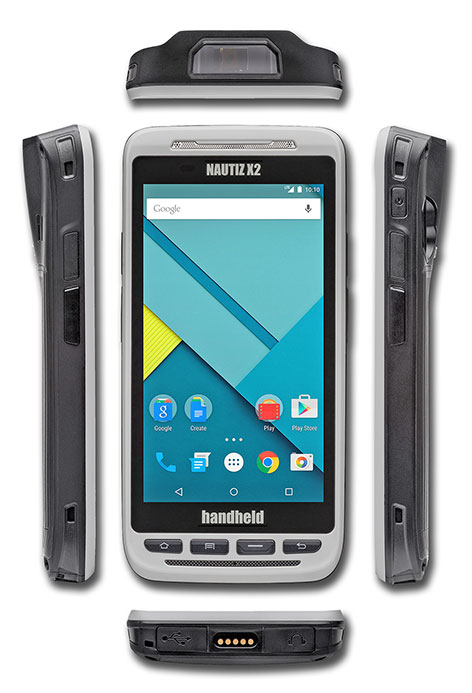
The footprint of the Nautiz X2 is almost identical to that of the Apple iPhone 7 Plus. However, the Nautiz X2 display measures 4.7 inches diagonally whereas the iPhone 7 Plus has a 5.5-inch screen. With consumers apparently wanting maximum-size screens, why did Handheld not go all the way to an iPhone 7 Plus class screen?
First, because the Nautiz X2 has extra protection around its display. Just glass all around wouldn't do out there in the field. And a 5.5-inch screen with extra perimeter protection around it would be too large for a handheld.
Second, the 4.7-inch screen leaves room for physical buttons in addition to on-screen buttons. Physical buttons are much easier to locate and they are more reliable for operation in rough environments.
And third, while the large size of iPhone 6/7 Plus class devices is accepted in the marketplace, the 4.7-inch iPhones actually outsell the larger ones by a good margin. So offering a very popular display size in a device no bigger than leading full-size consumer smartphones makes perfect sense.
Whereas the latest consumer smartphones have virtually no hardware buttons left, that wouldn't work well in the field where it can get wet and grimy and very hot or cold. So the Nautiz X2 has four physical buttons below the display. Three of them are standard Android keys (home, tasks, back). In the third position is what Handheld calls the primary scan key, which has a slightly different contour to make it noticeable as your finger glides over it.
The physical buttons are very legible with their white labels on black keys. But why the primary scan key is mixed in with the Android keys is unusual. There are two additional scan keys, one on the left and one on the right side of the device. These are unmarked, as is a second set of user-definable keys. There is a special setting to assign those to volume up and volume down, but they can be used for other purposes as well.
The overall design is quite pleasing, using the Handheld Group's traditional design language and light-gray and black color scheme. The Nautiz X2 is very ergonomically shaped. When holding the device in the palm of one's hand, fingers easily reach and operate all side buttons easily.
The technology under the hood
Assessing the technology and performance of an Android device is quite different from that of a Windows device. Those are fairly easily pegged. After reviewing and benchmarking Wintel devices for decades, one look at the spec sheet is usually enough to get an idea of where a device fits into the performance landscape.
Smartphones and Android-based handhelds may come with processors from Qualcomm, nVidia, Samsung, Texas Instruments and numerous other licensees of the ARM architecture that dominates smartphones. And there seems to be little of the brand loyalty that can be seen in desktops and laptops. Handheld itself uses four different CPU vendors for its five current Nautiz models.
 For the Nautiz X2, Handheld chose the 64-bit 1.3GHz quad-core Cortex-A53 MT6735 processor from MediaTek. The chip is based on the ARMv8-A instruction set, and the Cortex-A53 is the successor to the popular Cortex-A7. For graphics, the MT6735 also includes an ARM Mali-T720 GPU running at 600MHz. For the Nautiz X2, Handheld chose the 64-bit 1.3GHz quad-core Cortex-A53 MT6735 processor from MediaTek. The chip is based on the ARMv8-A instruction set, and the Cortex-A53 is the successor to the popular Cortex-A7. For graphics, the MT6735 also includes an ARM Mali-T720 GPU running at 600MHz.
MediaTek introduced the MT6735 in mid-2015 as a "WorldMode" smartphone platform designed to allow seamless roaming across high-speed 4G LTE networks for uninterrupted service, and merging 2G, 3G and 4G technologies by supporting FDD/TDD-LTE, WCDMA, CDMA2000, TDS-CDMA, EVDO, GSM, and EDGE.
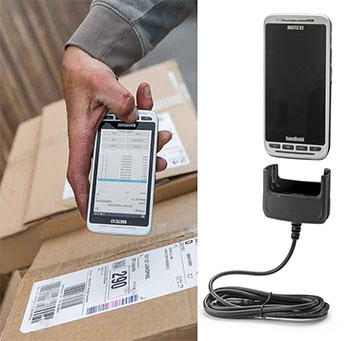 The MT6735 is based on 28nm process lithography and has been used, among other devices, in several Acer Liquid Series smartphones. In our benchmark testing (BaseMark OSII, AnTuTu, and Vellamo), the Handheld Nautiz X2 scored roughly on par with the company's larger Algiz RT7 tablet. The MT6735 is based on 28nm process lithography and has been used, among other devices, in several Acer Liquid Series smartphones. In our benchmark testing (BaseMark OSII, AnTuTu, and Vellamo), the Handheld Nautiz X2 scored roughly on par with the company's larger Algiz RT7 tablet.
The Nautiz X2 display is of the IPS variety, which means it has virtually perfect viewing angles from all directions. 1280 x 720 resolution makes for 312ppi (pixels per inch). That's in the same class as Apple's "retina" phones and super-sharp. There's 8GB of internal mass storage. That's not much, but it can be complemented via microSDHC card (which iPhones don't have).
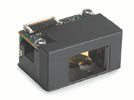 The Nautiz X2 can be used for bar code reading, too. And we're talking industrial-grade 1D/2D scanning, and not just using an app and the device's camera. The 1D scanner is a Zebra SE965HP laser (see here) designed for heavy-duty 1D scanning. This little engine has an exceptional range from near contact all the way to 15 feet. It does that with adaptive image scanning technology that automatically toggles between a wide and narrow scan angle until a barcode is detected. It's fast, too, with a theoretical top speed of over 100 scans per second. The Nautiz X2 can be used for bar code reading, too. And we're talking industrial-grade 1D/2D scanning, and not just using an app and the device's camera. The 1D scanner is a Zebra SE965HP laser (see here) designed for heavy-duty 1D scanning. This little engine has an exceptional range from near contact all the way to 15 feet. It does that with adaptive image scanning technology that automatically toggles between a wide and narrow scan angle until a barcode is detected. It's fast, too, with a theoretical top speed of over 100 scans per second.
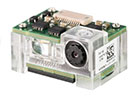 The available 2D scanner is a Honeywell N3680 1D/2D imager (see here) with Adaptus 6.0 technology. The N3680 supports a wide set of 1D and 2D barcode symbologies, along with advanced imaging capabilities such as reading poorly printed bar codes and reading barcodes directly from smartphone screens. The available 2D scanner is a Honeywell N3680 1D/2D imager (see here) with Adaptus 6.0 technology. The N3680 supports a wide set of 1D and 2D barcode symbologies, along with advanced imaging capabilities such as reading poorly printed bar codes and reading barcodes directly from smartphone screens.
For navigation, Handheld's documentation states that the device contains a "high-performance navigation chip" but it doesn't say which and what it can do. The spec sheet suggests that the Nautiz X2 supports both GPS and GLONASS. Concurrent use of both would mean almost twice the number of available satellites for increased accuracy.
Construction and components of the Nautiz X2
One of our favorite tech sites in the world is fixit.com, the folks who built a business around taking electronic devices apart, rating them according to how difficult it is to fix them. RuggedPCReview also takes gear apart, but we do it to examine whether a product is as tough and rugged inside as it is outside. And also to see how well it is sealed and how capable it likely is to perform under extreme conditions.
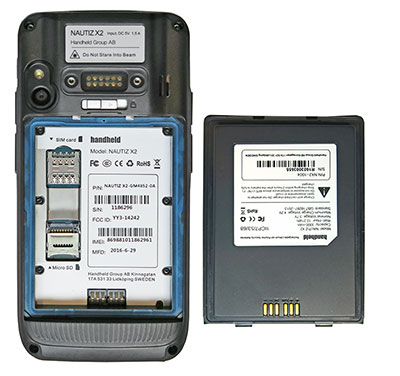 That said, let's see how the Nautiz X2 is built. Compared to the boring monolithic design of virtually every consumer smartphone today, the Nautiz X2 is interestingly contoured and styled. On the backside it's instantly clear where the camera, flash and speaker are, where the scanner is, and how to access the battery. That said, let's see how the Nautiz X2 is built. Compared to the boring monolithic design of virtually every consumer smartphone today, the Nautiz X2 is interestingly contoured and styled. On the backside it's instantly clear where the camera, flash and speaker are, where the scanner is, and how to access the battery.
The battery cover actually is the battery. It is a 3.7V, 3,300mAh, 12.21 watt-hour Lithium-Ion Polymer "security" battery. That's 10% more capacity than the iPhone 7 Plus has. The battery presses against a blueish translucent flat ribbon gasket seal that's sitting on a lip going around the perimeter of the battery compartment.
A springloaded left-right lever keeps the battery in place and pressing against the seal. It is unlikely that it will come loose by accident. The ribbon gasket is replaceable, and it's easy to check it for damage.
Both the battery and the bottom of the battery compartment have precision-cut white plastic foil with instructions, labels, barcodes and whatever else is required to quickly identify things. That makes for a very professional look.
Inside the battery compartment are the Nautiz X2's SIM card and microSD card slots. The microSD slot if of the caddy variety where you first push the upper part forward to then rotate it up before you can place the card in it. We prefer the slot kind where you simply push the card in. Those are less likely to get damaged.
Like virtually all handheld devices, the Nautiz X2 consists of a top and a bottom half. They are held together by six tiny Philips screws inside the battery compartment, and four larger Torx 5 screws on each of the four corners of the bottom part of the housing. The latter have tiny rubber rings for extra sealing. Do not lose those and make sure they are in place for reassembly.
Below you can see the inside of the Nautiz X2, with the topside on the left and the bottom half on the right.
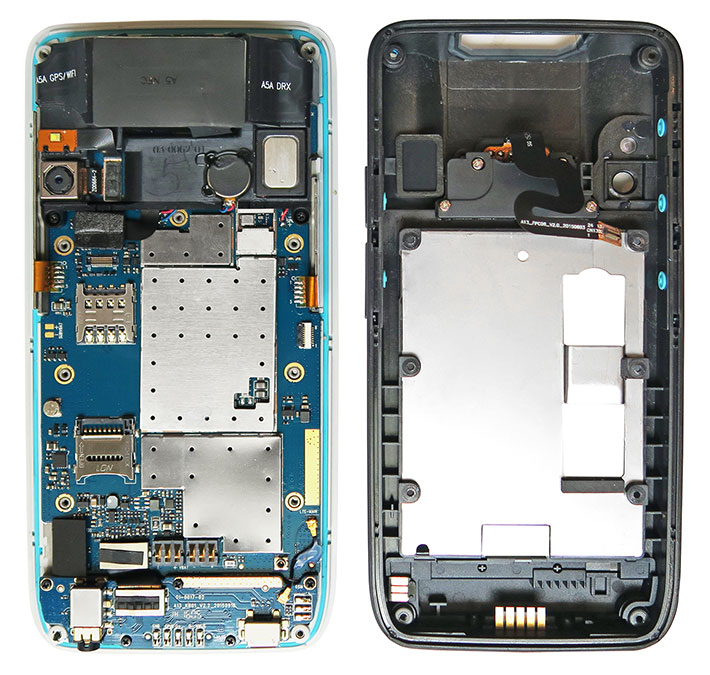
The two halves come apart easily. There is one custom ribbon connector that needs to be disengaged. Fortunately, it's not one of the tiny locking clip connectors that can drive even seasoned service technicians to reach for a shot of akvavit. The two halves — the front in light gray, the back in black, as is always the case with Handheld Group devices — use a tongue-and-groove design with a replaceable rubber seal. It's turquoise and thus easily visible and easy to check, it has tabs for precise placement, and the groove is a simple rectangle with rounded corners. Good job.
We mention the type of seal because complex seals that tear easily and aren't easily visible may compromise the sealing and thus the integrity of the device. And that can be the difference between reliable operation even under tough environmental conditions, or not.
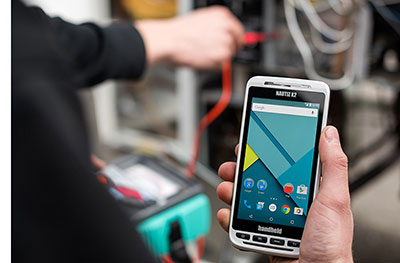 Another observation: there are no loose parts. Sometimes, when we open a device for examination, all sorts of stuff falls out. That's no real big deal, but loose things can get lost, or they may be put back in place wrong. No loose stuff is better. Another observation: there are no loose parts. Sometimes, when we open a device for examination, all sorts of stuff falls out. That's no real big deal, but loose things can get lost, or they may be put back in place wrong. No loose stuff is better.
Rugged handheld usually have a rigid internal metal frame to mount the display and the motherboard on. At first sight, the Nautiz X2 doesn't appear to have one, but it is there, hidden underneath the motherboard that covers the entire interior surface of the device. Most of the circuitry and components is hidden beneath custom-cut metal covers, presumably for shielding.
The black plastic assembly visible in the top quarter of the device houses the documentation camera with its LED flash, the scanner, as well as GPS, WiFi, NFC and related functionality. All of this is underneath or part of this plastic "cowl."
One detail that had us scratch our heads was what appeared to be a super-fine mesh covering the two small speaker openings inside. There doesn't appear to be clear plastic over it. There is, however, a rubber ribbon seal around the mesh, and so we assume it's an interesting solution to allow both lous, clear sound and IP65 sealing.
The Android vs Windows issue
On the software side, the Nautiz X2 comes with Android 5.1 "Lollipop." According to the Android Developers page, Lollipop had a 35.0% marketshare among all Android versions in September 2016 (see here), the largest of any Android platform versions (ver. 4.4 "KitKat" was second with 27.7%). Note that Lollipop introduced enterprise-strength security to Android, moving the platform a big step forward.
 Further, the Nautiz X2 is one of the rare enterprise handhelds with Google GMS (Google Mobile Services) certification. This means it's been certified by Google and comes with Google-branded apps (such as Maps, Gmail, Drive, etc.) and has access to the Google Play store (we wish Google would change the name of its app store! It's far more than play). Further, the Nautiz X2 is one of the rare enterprise handhelds with Google GMS (Google Mobile Services) certification. This means it's been certified by Google and comes with Google-branded apps (such as Maps, Gmail, Drive, etc.) and has access to the Google Play store (we wish Google would change the name of its app store! It's far more than play).
A few words here about the Android vs Windows operating system issue. For the past several years the situation was that Microsoft Windows dominates on desktop and notebook computers (with only Apple as a serious general purpose alternative) whereas Android almost completely rules smartphones (again, with only Apple as a serious competitor). So you'd think that Android is dominant in rugged mobile devices as well.
Interestingly, that's not the case. In the rugged mobile computing market Windows Mobile, later renamed Windows Embedded Handheld, continued to dominate for years after Microsoft essentially stranded the OS, leaving it without a feasible upgrade or migration path. Somehow, Android did not manage to take advantage of the situation. And with Microsoft now pushing Windows 10's "unified core" for all Windows devices, no one knows whether the new Windows 10 IoT Mobile Enterprise will tip the industrial small devices market in Microsoft's favor, or if Android's dominant marketshare in smartphones will carry the day.
So, for now, there is still no clear direction in the rugged tablet market as far as operating systems go. Most major rugged handheld and tablet vendors offer both Windows and Android, often in the same or very similar hardware. The way we see it, Android has a clear usability and familiarity advantage in smartphone-like devices whereas Windows, of course, has an equally clear legacy systems and software edge.
With so many users familiar with Android, there is no doubt that an Android-based rugged industrial and enterprise device will have instant appeal and familiarity, more so than is the case with Microsoft's tile approach. Add to that the massive number of Android apps and the readily available Android software development expertise, and deploying Android devices on the job looks like a winning strategy.
Excellent display
For some reason, display technology doesn't get much respect. It's always all about processors and how much RAM and storage and what OS and which version. That's weird because the quality of the display is as much or more important to the overall user experience and user satisfaction.
Computer displays used to be terrible. Just start up an old laptop, even one that at the time looked pretty good, and you see how very bad they used to be. Then they quickly got a lot better, with much better and brighter colors, but still they were unreadable outdoors. About a decade ago polarizers and optical coatings improved matters a great deal. But then things stagnated yet again, with old LCD technologies hanging around and insufficient screen resolutions.
Then smartphones came along and competition drove screen resolutions into the stratosphere, at least on small devices, and that's basically where we are now. There still aren't any perfect displays for outdoor use, but viewability is much better than it used to be.
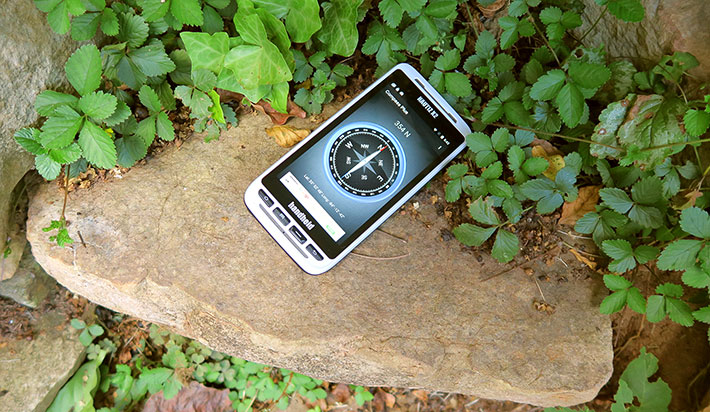
And that gets us to the Nautiz X2's display. A screen measuring 4.7-inches diagonal would have been considered huge on a handheld device not too long ago. Now it looks just about right. It has 1,280 x 720 pixel resolution, which translates into 312 pixels per inch and is in the same class as Apple's "retina" phones and super-sharp.
But sharpness alone isn't everything. Viewing angle also matters very much in handhelds. There's nothing worse than having to hold your phone just so in order to get the best picture. For a satisfying viewing experience you need to be able to look at the screen from any angle without the image looking any different.
So how well does the Nautiz X2 display work, and how good does it look? Below are a few comparison pictures with an Apple iPhone 6 Plus. The 6 Plus sports an excellent display that's said to be in the 550 nits range. Can the Nautiz X2 keep up with that?
The first comparison picture shows the two phones outdoors but in the shade. Both are set to automatic brightness. We don't know how much each had in reserve, but the Nautiz X2 certainly holds its own.
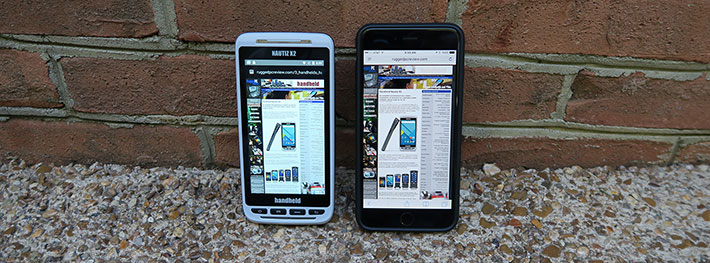
In the second picture below, we're looking at the devices from a side-angle. Both have IPS displays, which means they have near perfect viewing angles without any of the color and contrast shifts that mar lesser LCD technologies. However, some IPS implementations and some optical treatments can make displays look considerably dimmer when viewed from an angle. The iPhone actually suffers a little bit from that syndrome. The Nautiz X2 doesn't.
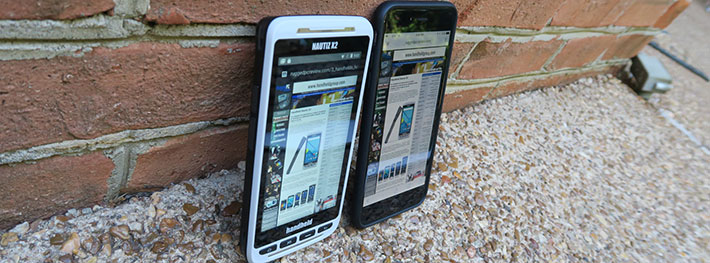
Sometimes the horizontal viewing angle of a display is very good but the vertical one isn't. So we checked that. Both devices pass that test with flying colors.
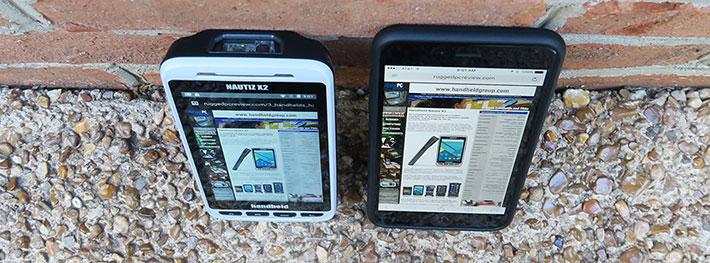
The final comparison image below shows both units sitting on the ground in bright, strong sunshine. This is where current display technology meets its limits. The glossy displays (which both units have) that make colors pop struggle controlling reflections, and even strong backlights are no much for the sun. There's good news, though. Ten years ago, LCDs washed out completely outdoors. Now, the best ones don't. The iPhone has one of the best. But the Nautiz X2 matches it every step.
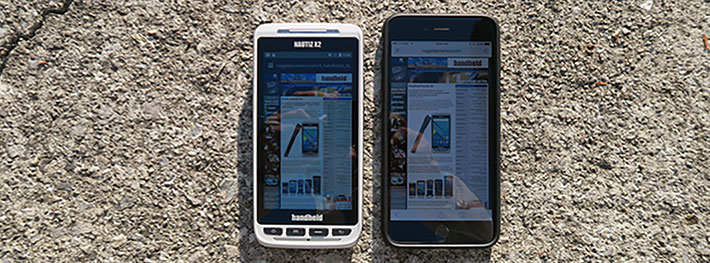
Given that the iPhone isn't a rugged device designed specifically for outdoor use, shouldn't the Nautiz have beaten it outright? No. There are technology limits, and hanging with an iPhone and at times beating it is about as good as it gets today.
Camera for use on the job
If someone had told us here at RuggedPCReview (and before that at Pen Computing Magazine) that cameras built into rugged handhelds would one day become as good as the one in the Nautiz X2, we wouldn't have believed it. Sometimes it seems like they went from truly terrible and useless to amazingly good in almost no time at all. Anyone who has doubts that a camera integrated into an industrial mobile computer can get the job done, or anyone who has accepted the fate of needing to carry both a phone and a camera, rejoice: while no replacement for a digital SLR, the Nautiz X2 camera gets most jobs done.
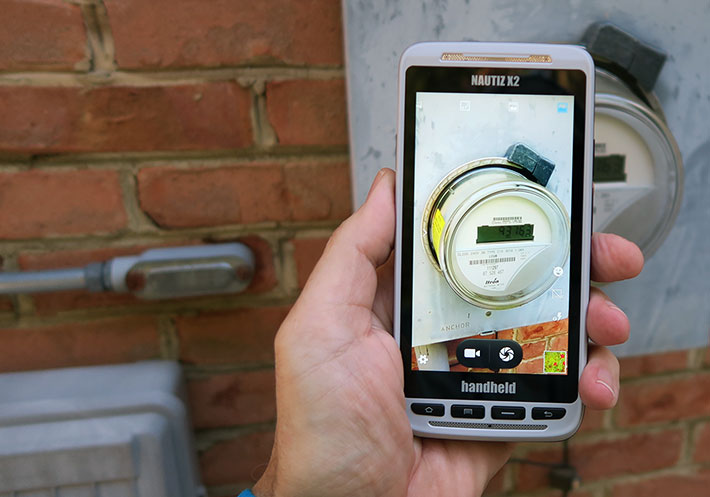
The Nautiz X2's integrated documentation camera can take images with resolutions of up to eight megapixel. It also has an LED illuminator that you can turn on and off via software to add extra light. It's not a flash in terms of power, but certainly helps taking better pictures in marginal lighting conditions.
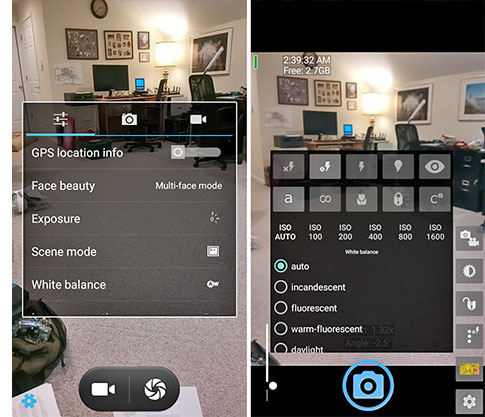 The default Camera app that came with our review unit allows shooting in 1, 4, and 6 megapixel stills, and video in low, medium, high and fine quality. Since the Nautiz X2 has an 8mp imager, it appears that the default camera app isn't quite optimized for the Nautiz X2's camera hardware. We downloaded Mark Harman's excellent and free Open Camera app from the Google store to have access to all the image size settings, but did the test pictures with the default app. The default Camera app that came with our review unit allows shooting in 1, 4, and 6 megapixel stills, and video in low, medium, high and fine quality. Since the Nautiz X2 has an 8mp imager, it appears that the default camera app isn't quite optimized for the Nautiz X2's camera hardware. We downloaded Mark Harman's excellent and free Open Camera app from the Google store to have access to all the image size settings, but did the test pictures with the default app.
See example camera UI screen snaps to the right, first the default camera, then Mark Harman's Open Camera.
In the default camera, there are 14 screen settings, three flash settings, 8 white balances, you can turn HDR and GPS location on or off, do 2 or 10 second timers, and change exposure from -3 to +3. There are settings for face detection, anti-shake, shutter delay, 16-shot continuous, ISO, etc. There is a multi-view mode, a panorama mode, a motion track mode, a live photo mode, in addition to the standard mode.
Things are quite elaborate in the post-processing area. There, you can apply various preset filters (like vintage, punch, litho, etc.), select frame types, crop, straighten, rotate, mirror, or draw. You can also change exposure, contrast, highlights, shadows, vibrance, sharpness, curves, hue, saturation and plenty more. It's, of course, no substitute for a powerful desktop imaging app, but it certainly allows for quick fixes.
The test pictures with the Nautiz X2 camera were much better than what we've seen in the past from mobile computer cameras. Below are some sample shots we took with the documentation camera. Click on the picture to get a full-size version.
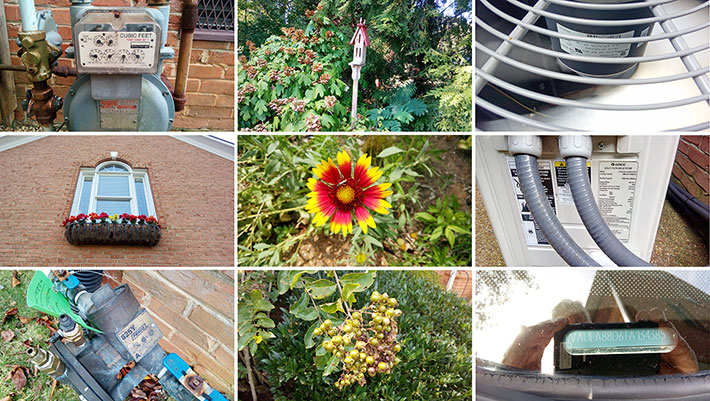
Overall, the Nautiz X2 camera is capable of taking very good pictures, much better than we generally see from industrial handhelds. There is very good sharpness and image detail, and virtually none of the massive compression that in the past used to render pictures from such integrated cameras useless. The lag and occasional hiccups that made older onboard integrated cameras nearly useless are also completely gone.
Video, likewise, is much improved compared to what we're used to seeing from cameras integrated into rugged devices. Frame rate and focussing are absolutely quick enough to be used on the job. The autofocus is unobtrusive and without the frequent hunting that used to mar such cameras. And the camera never fell behind in our (limited) video testing.
The brief video clip to the right was taken with the XT7 camera in 720p resolution. Here, again, the default camera app was lacking. While it was possible to set things like noise reduction, electronic image stabilization, time lapse intervals from 1 to 10 seconds, and video quality, there did not appear to be a setting for recording size.
Note that the camera applications that come with mobile operating systems are often replaced with third party applications optimized for certain tasks, or developers and systems integrators include camera and video functionality directly into custom applications.
As is, the still image and video functions of the Nautiz X2 are good enough for most documentation jobs out there in the field. It is truly amazing how quickly integrated imaging has gone from nearly useless to quite excellent.
Ruggedness: no need for a protective case
Right upfront: can anyone out there think of a single reason why a phone should be so super-thin, glitzy, fragile, and scratch-prone that the first thing virtually every user does is buy a case for it? Makes zero sense. And, fortunately, Nautiz X2 users won't have to worry about any of that, because the device is no such fragile, scratch-prone, crush-prone flower. It's tough. Very tough.
According to its specs, the Nautiz X2 can handle a very wide operating temperature range from -4 to 122 degrees Fahrenheit (-20 to 50 Celsius). That's good enough for most deployments, except for extremest heat or cold. It carries IP65 sealing where the "6" means the computer is totally protected from dust, and the "5" that it is protected against low pressure jets of water from all directions. The Nautiz X2 also passed the MIL-STD-810G 516.6. Procedure IV test of 26 drops from a height of four feet to concrete. What does all this mean?
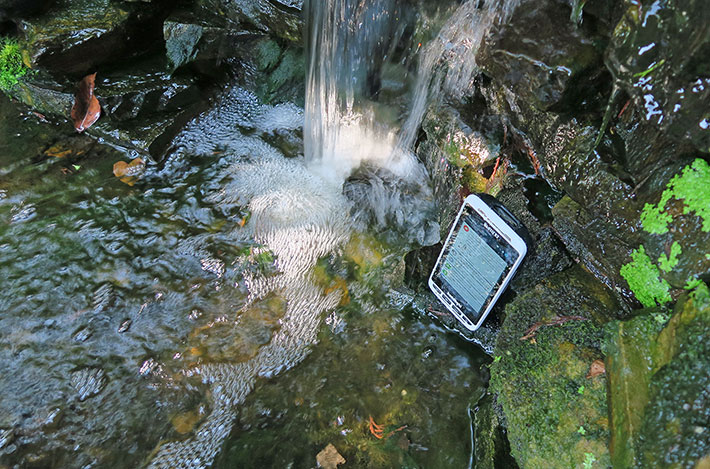
As far as operating temperature goes, the device can be used in most environments where someone would be expected to work with a computer. The folks at the Handheld Group's native Sweden know a thing or two about ice and snow and working in the cold, so we're sure they have low temperature suitability covered, and not having rotating media onboard certainly helps.
 Given that Handheld's own Algiz RT7 and 10X tablets can handle 4-foot drops, we're a bit surprised that the Nautiz X4 is also rated at just four feet. Smaller, lighter devices are inherently more resistant to drop damage, and the Nautiz X2 certainly feels like it could handle much higher drops. Why are we being picky here? Because rugged tablets and laptops must be able to handle four foot drops because that about the height they may fall while being used in a standing position. Phones, on the other hand, may easily be dropped from five or six feet when they are being used for a call. And that's why we'd like to see six feet here. Given that Handheld's own Algiz RT7 and 10X tablets can handle 4-foot drops, we're a bit surprised that the Nautiz X4 is also rated at just four feet. Smaller, lighter devices are inherently more resistant to drop damage, and the Nautiz X2 certainly feels like it could handle much higher drops. Why are we being picky here? Because rugged tablets and laptops must be able to handle four foot drops because that about the height they may fall while being used in a standing position. Phones, on the other hand, may easily be dropped from five or six feet when they are being used for a call. And that's why we'd like to see six feet here.
Likewise, IP65 is good sealing, but it's not IP67 which is increasingly expected in rugged outdoor gear, thanks to a growing number of IP67-rated active lifestyle consumer smartphones. So why not IP67, which protects a device even against immersion into water to a depth of about three feet? Probably because it's much more involved to seal a device with multiple openings and a large, replaceable battery than it is to seal one that doesn't even have a headphone jack.
That said, this also must be said: Apple claims its new iPhone 7 is IP67 rated. But then goes on to say that the device is "splash, water, and dust resistant" and that those are "not permanent conditions and resistance might decrease as a result of normal wear." In the rugged world, that might be considered IP54, but certainly not IP67. And it hardly sounds trust-inspiring. Whereas we didn't hesitate at all to plop the Nautiz X2 into the drink.
In another example of consumer smartphone ruggedness rhetoric, Samsung claimed that their Galaxy S7 active had been tested against a subset of 20 MIL-STD-810G specifications and was IP68 sealed.
However, when Consumer Reports tested the Galaxy S7 active's IP68 claim (30 minutes at a depth of 5 feet), the Samsung phone failed and died (see here). Making exaggerated ruggedness claims that may result in failure on the job certainly doesn't inspire confidence. Handheld, in our experience, would never let anything like that happen. Nor would we expect it from a company that is 100%-dedicated to making rugged mobile computing products.
Vibration resistance was tested as described in MIL-STD-810G, Method 514.6, Procedures I & II, for general vibration in a fixed mounting and a loose cargo test, but there is no detailed description. This would be good to have as many Nautiz X2 devices will likely see their share of being rattled and bopped around. The Nautiz X2 can handle operating altitudes up to 15,000 feet. This is relevant not only for use in mountainous areas, but also in unpressurized airplanes. The device was also tested according to MIL-STD-810G, Method 507.5 for humidity resistance.
While some customers will probably want to see actual lab reports with more specific detail, and we'd like to see the Handheld Group take a more aggressive stance in some of its ruggedness ratings, the overall impression of the Nautiz X2 is that it's indeed a remarkably rugged device that is capable of handling a substantial degree of abuse.
Summary: Handheld Group Nautiz X2
With the Nautiz X2, the Handheld Group offers a modern, practical solution for anyone who needs contemporary Android smartphone functionality on the job, but in a package that won't break on the job and that also includes tools for the job, like industrial-grade scanning.
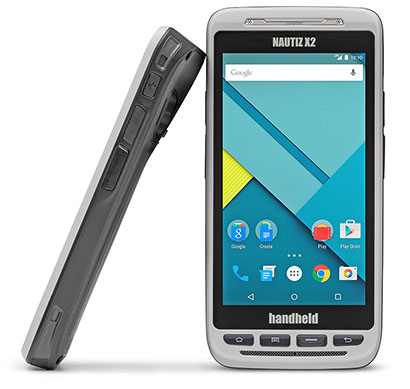 With a footprint roughly the same as that of the iPhone 7 Plus, the attractively styled Nautiz X2 remains manageable in size and weight. It's quite pocketable and gets high marks both in ergonomics and functionality. With a footprint roughly the same as that of the iPhone 7 Plus, the attractively styled Nautiz X2 remains manageable in size and weight. It's quite pocketable and gets high marks both in ergonomics and functionality.
The bright and vibrant 4.7-inch sunlight-viewable capacitive multi-touch screen IPS display is very sharp and offers near perfect viewing angles from all directions, without any color or contrast shifts. The touch screen is responsive and can even be used with thin gloves..
Unlike any consumer smartphone, the Nautiz X2 is rugged enough to be used in any environment, without even needing a bulky case. The onboard microUSB and 3.5mm audio ports are protected by unobtrusive, well-fitting plugs. The battery is replaceable in seconds, and the Nautiz X2 has a microSD card slot.
The unit provides excellent wireless functionality (WiFi, WWAN, Bluetooth, GPS, NFC). Industrial-grade integrated 1D laser or 1D/2D imager scanning is available also. The integrated 8mp documentation camera is capable of very good, but there's no user-facing camera.
Overall, Handheld's own product news release is very much on the mark: "The Nautiz X2 gives enterprise users an all-in-one mobile computer that can handle all the tasks of a day's work, with built-in ruggedness that allows it to be used anywhere from a warehouse to challenging outdoor environments with moisture, dust, extreme high or low temperatures and potential drops." -- Conrad H. Blickenstorfer, September 2016
Handheld Group Nautiz X2 Specifications:
| Status |
Added 07/2016, full review 09/2016
|
| Type |
Rugged Smartphone
|
| Processor |
MediaTek MT6735 quad-core processor (4 x ARM Cortex-A53, 28nm) |
| Processor speed |
1.30GHz |
| OS |
Android version 5.1.1 (Lollipop) |
| Graphics |
Mali-T720 |
| RAM/ROM |
1GB RAM/8GB Flash |
| Display type |
Sunlight-readable 4.7-inch IPS TFT with Gorilla Glass |
| Display resolution |
1280 x 720 pixel (312 ppi)
|
| Digitizer/Pens |
Projected capacitive multi-touch |
| Keyboard |
Onscreen + 4 function keys + scan buttons |
| Expansion |
1 x microSDHC, 1 x SIM |
| Housing |
Polymer plastics over magnesium alloy frame |
| Operating temperature |
-4° to 122°F (-°20 to 50° Celsius)
|
| Shock |
26 4-feet drops to concrete per MIL-STD-810G Method 516.6, Procedure IV
|
| Vibration |
TBA
|
| Enclosure Class |
IP65, MIL-STD-810G, IEC 60529 |
| Hazardous materials |
unknown |
| Size |
5.9 x 2.9 x 0.62 inches (150 x 74 x 16 mm) |
| Weight |
8.1 ounces (230 grams)
|
| Power |
3.7V, 3,330mAH, 12.21 whr Li-Ion
|
| Camera |
Rear-facing 8mp auto-focus camera with LED flash
|
| Scanning |
Optional 1D Zebra SE965HP laser or 1D/2D Honeywell N3680 imager
|
| Sensors |
G-sensor, ambient light, proximity
|
| Interface |
Micro USB OTG, 3.5mm audio, dock
|
| Communications |
Dual-band 802.11a/b/g/n WiFi, Bluetooth 4.0 LE, WWAN (GSM/HSPA+, 4G LTE), GPS/Glonass
|
| Price |
Starts at US$999
|
| Product brochure |
 Nautiz X2 brochure Nautiz X2 brochure |
| Web page |
Handheld Group Nautiz X2 web page |
| Contact |
Handheld Group AB
Kinnegatan 17A
531 33 Lidköping, Sweden
Tel: +46 (0) 510 54 71 70
Fax: +46 (0) 510 282 05
Web: www.handheldgroup.com
Email: info at handheldgroup.com
|
HHCS Handheld USA Inc.
33870 SE Eastgate Circle
Corvallis, OR 97333, USA
Tel: (541) 752-0313
Fax: (541) 752-0338
Web: www.handheld-us.com
Email: info at handheld-us.com
|
|
(copyright 2016 RuggedPCReview.com)
|









 So the idea here was to create a device that's both a competent, modern smartphone as well as a workable data collection tool for the shop floor or the field. The image to the right shows how the new Nautiz X2 fits into the Handheld Group's current product line.
So the idea here was to create a device that's both a competent, modern smartphone as well as a workable data collection tool for the shop floor or the field. The image to the right shows how the new Nautiz X2 fits into the Handheld Group's current product line.


 For the Nautiz X2, Handheld chose the 64-bit 1.3GHz quad-core Cortex-A53 MT6735 processor from MediaTek. The chip is based on the ARMv8-A instruction set, and the Cortex-A53 is the successor to the popular Cortex-A7. For graphics, the MT6735 also includes an ARM Mali-T720 GPU running at 600MHz.
For the Nautiz X2, Handheld chose the 64-bit 1.3GHz quad-core Cortex-A53 MT6735 processor from MediaTek. The chip is based on the ARMv8-A instruction set, and the Cortex-A53 is the successor to the popular Cortex-A7. For graphics, the MT6735 also includes an ARM Mali-T720 GPU running at 600MHz.
 The MT6735 is based on 28nm process lithography and has been used, among other devices, in several Acer Liquid Series smartphones. In our benchmark testing (BaseMark OSII, AnTuTu, and Vellamo), the Handheld Nautiz X2 scored roughly on par with the company's larger Algiz RT7 tablet.
The MT6735 is based on 28nm process lithography and has been used, among other devices, in several Acer Liquid Series smartphones. In our benchmark testing (BaseMark OSII, AnTuTu, and Vellamo), the Handheld Nautiz X2 scored roughly on par with the company's larger Algiz RT7 tablet.
 The Nautiz X2 can be used for bar code reading, too. And we're talking industrial-grade 1D/2D scanning, and not just using an app and the device's camera. The 1D scanner is a Zebra SE965HP laser (
The Nautiz X2 can be used for bar code reading, too. And we're talking industrial-grade 1D/2D scanning, and not just using an app and the device's camera. The 1D scanner is a Zebra SE965HP laser ( The available 2D scanner is a Honeywell N3680 1D/2D imager (
The available 2D scanner is a Honeywell N3680 1D/2D imager ( That said, let's see how the Nautiz X2 is built. Compared to the boring monolithic design of virtually every consumer smartphone today, the Nautiz X2 is interestingly contoured and styled. On the backside it's instantly clear where the camera, flash and speaker are, where the scanner is, and how to access the battery.
That said, let's see how the Nautiz X2 is built. Compared to the boring monolithic design of virtually every consumer smartphone today, the Nautiz X2 is interestingly contoured and styled. On the backside it's instantly clear where the camera, flash and speaker are, where the scanner is, and how to access the battery.

 Another observation: there are no loose parts. Sometimes, when we open a device for examination, all sorts of stuff falls out. That's no real big deal, but loose things can get lost, or they may be put back in place wrong. No loose stuff is better.
Another observation: there are no loose parts. Sometimes, when we open a device for examination, all sorts of stuff falls out. That's no real big deal, but loose things can get lost, or they may be put back in place wrong. No loose stuff is better.
 Further, the Nautiz X2 is one of the rare enterprise handhelds with Google GMS (Google Mobile Services) certification. This means it's been certified by Google and comes with Google-branded apps (such as Maps, Gmail, Drive, etc.) and has access to the Google Play store (we wish Google would change the name of its app store! It's far more than play).
Further, the Nautiz X2 is one of the rare enterprise handhelds with Google GMS (Google Mobile Services) certification. This means it's been certified by Google and comes with Google-branded apps (such as Maps, Gmail, Drive, etc.) and has access to the Google Play store (we wish Google would change the name of its app store! It's far more than play).






 The default Camera app that came with our review unit allows shooting in 1, 4, and 6 megapixel stills, and video in low, medium, high and fine quality. Since the Nautiz X2 has an 8mp imager, it appears that the default camera app isn't quite optimized for the Nautiz X2's camera hardware. We downloaded Mark Harman's excellent and free Open Camera app from the Google store to have access to all the image size settings, but did the test pictures with the default app.
The default Camera app that came with our review unit allows shooting in 1, 4, and 6 megapixel stills, and video in low, medium, high and fine quality. Since the Nautiz X2 has an 8mp imager, it appears that the default camera app isn't quite optimized for the Nautiz X2's camera hardware. We downloaded Mark Harman's excellent and free Open Camera app from the Google store to have access to all the image size settings, but did the test pictures with the default app.


 Given that Handheld's own Algiz RT7 and 10X tablets can handle 4-foot drops, we're a bit surprised that the Nautiz X4 is also rated at just four feet. Smaller, lighter devices are inherently more resistant to drop damage, and the Nautiz X2 certainly feels like it could handle much higher drops. Why are we being picky here? Because rugged tablets and laptops must be able to handle four foot drops because that about the height they may fall while being used in a standing position. Phones, on the other hand, may easily be dropped from five or six feet when they are being used for a call. And that's why we'd like to see six feet here.
Given that Handheld's own Algiz RT7 and 10X tablets can handle 4-foot drops, we're a bit surprised that the Nautiz X4 is also rated at just four feet. Smaller, lighter devices are inherently more resistant to drop damage, and the Nautiz X2 certainly feels like it could handle much higher drops. Why are we being picky here? Because rugged tablets and laptops must be able to handle four foot drops because that about the height they may fall while being used in a standing position. Phones, on the other hand, may easily be dropped from five or six feet when they are being used for a call. And that's why we'd like to see six feet here.
 With a footprint roughly the same as that of the iPhone 7 Plus, the attractively styled Nautiz X2 remains manageable in size and weight. It's quite pocketable and gets high marks both in ergonomics and functionality.
With a footprint roughly the same as that of the iPhone 7 Plus, the attractively styled Nautiz X2 remains manageable in size and weight. It's quite pocketable and gets high marks both in ergonomics and functionality.
